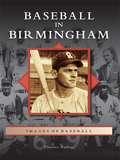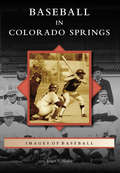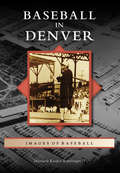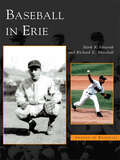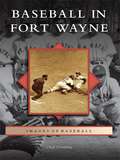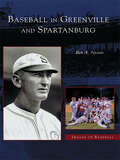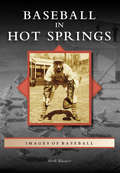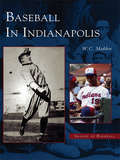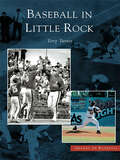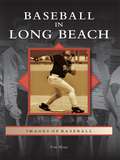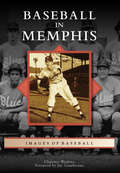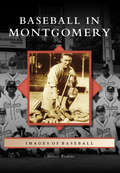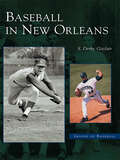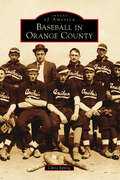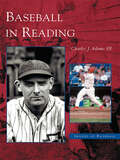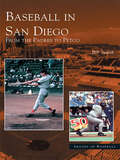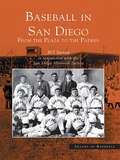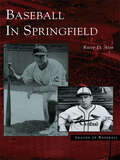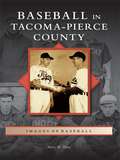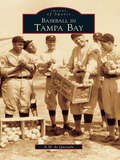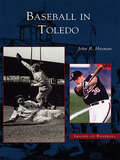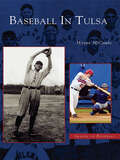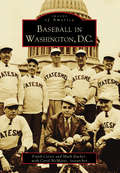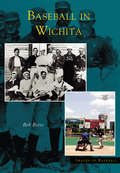- Table View
- List View
Baseball in Birmingham (Images of Baseball)
by Clarence WatkinsThe Birmingham Barons were a charter member of the old Southern League in 1885. Built in 1910, Rickwood Field, longtime home of the Barons, is recognized as the oldest surviving, professional baseball park in the nation. The Barons now play at the newly remodeled Regions Park in Hoover, Alabama. In spite of the popularity of football in Alabama, Birmingham continues to be a leader in minor league baseball, winning the prestigious Bob Freitas Award in 2008. This award is given annually by Baseball America to the most outstanding franchise in each classification.
Baseball in Colorado Springs (Images of Baseball)
by Roger P. HadixFrom Boulevard Park and Memorial Field to Security Service Field (formerly Sky Sox Stadium), Colorado Springs is a baseball town. Professional baseball arrived in 1901; the Brown Bombers, a semiprofessional black team, came in the 1940s; and the original Sky Sox won the Western League Championship in 1953, 1955, and 1958. Local players such as Ed Kent, Bill Everitt, Jim Landis, Sam Hairston, Connie Johnson, Vinny Castilla, and Todd Helton have made it to the major leagues. Rich "Goose" Gossage, a Colorado Springs native, went directly from Class A ball to the Chicago White Sox, starting his hall-of-fame career in 1972.
Baseball in Denver (Images of Baseball)
by Matthew Kasper Repplinger IIImages of Baseball: Baseball in Denver shares the city's prominent role in America's great game. The lore of baseball's first pioneers plays out in a real-life soap opera for this Western city. From the early Hall-of-Fame players to the storied baseball-talent barons of Denver's primitive days, baseball has always been on the forefront of the Denver sports horizon. From Tinker to Satchel Paige to "The Babe" himself, the Mile High City has been a barnstormer's oasis in a town that was nothing short of the Wild West. The Denver Post Tournament and the rich history of the Denver Bears are highlighted, as well as the many fields and landmarks throughout the city. With the inception of the Colorado Rockies, Denver once again set the stage for big-league baseball, which many of Denver's local baseball legends have been no stranger to.
Baseball in Detroit: 1886-1968 (Images of America)
by David Lee PorembaCovering over 80 years of America's favorite pastime, Baseball in Detroit 1886-1968 takes fans back to the glory days of Ty Cobb in the early 20th century and follows the progress of the Detroit Tigers. From the three-time pennant winners of this century's first decade to the last real championship team of 1968, Detroiters have flocked to see their team play, win or lose. The fact that they have played at the same intersection of town for over a century is a tribute to the pride and loyalty that each has shown for the other. It could be said that no other baseball franchise has such a close relationship with its constituency. This relationship is clearly shown in a fascinating photographic collection, and sports fans everywhere will appreciate this candid glimpse into our nation's favorite game. As we approach the next millennium, a new stadium is under construction for this historic team. It, too, will be the place of legends, where great players and fans will create another glorious 100 years of baseball history in Detroit. The American League, to which the Detroit Tigers belong as charter members, is fast approaching its own centennial.
Baseball in Erie (Images of Baseball)
by Mark K. Vatavuk Richard E. MarshallErie has had a love affair with professional baseball since the 1880s, though it has been an on-again off-again relationship. Whatever they were called--the Olympics, Blackbirds, Sailors, or SeaWolves--the Flagship City's teams have thrilled fans and won championships. However, many of those local nines faded away, leaving behind memories and empty ballparks. Baseball in Erie is a tribute to the men who brought baseball to this region of Pennsylvania: ambidextrous pitcher Tony Mullane; infielder Louis Bierbauer, the "original" Pittsburgh Pirate; Sam "the Jet" Jethroe; "Turkey" Mike Donlin; Todd Zeile, the record-setting nomadic major-leaguer; and Jose Guillen, the first SeaWolves hero. Through photographs and memorabilia, Baseball in Erie reaches out to fans of the national pastime, especially those who were jammed into the rafters of Ainsworth Field and now bask in the beauty of Jerry Uht Park.
Baseball in Fort Wayne (Images of Baseball)
by Chad GramlingThe Fort Wayne Wizards' 1993 arrival marked the beginning of professional baseball in northeast Indiana for many. However, the city boasts a rich baseball heritage that traces its roots to the very origins of the game. In fact, baseball and its record books begin with Fort Wayne. Over more than 135 years, dozens of teams have called Fort Wayne their homefield, making players into local legends and stars who excelled in the spotlight of baseball's biggest stage. Baseball in Fort Wayne recounts the sport's presence in the city, from the earliest days of 1871's Kekiongas to today's Wizards, as well as those who took the field in between.
Baseball in Greenville and Spartanburg (Images of Baseball)
by Bob A. NestorBaseball, an important institution in every American town, takes centerfield in the histories of Greenville and Spartanburg, South Carolina. These two cities have hosted some of the most well-known players of all time, from Tommy Lasorda and Chipper Jones to "Shoeless Joe" Jackson, the man who will forever link Greenville and Spartanburg with America's game. Baseball in Greenville and Spartanburg chronicles the diamond game as it has been played in the Carolina Upstate. More than a century of games from the Minor League, Textile League, and Big League clubs, along with high school and collegiate teams, are showcased. An older Joe Jackson still plays ball, a patriotic Joe Anders impresses crowds in the 1940s, and the Greenville Spinners, Greenville Braves, and the Spartanburg Phillies bring the crowds to their feet. The greats teach the game to tomorrow's stars, while tomorrow's stars perfect their talent, all with the Blue Ridge Foothills rising in the distance.
Baseball in Hot Springs (Images of Baseball)
by Mark BlaeuerHot Springs, Arkansas, with its thermal water baths, attracted its first big-league outfit when the National League champion Chicago White Stockings traveled south for spring training in 1886. The baseball colony grew as dozens of other clubs followed. Individual players flocked here as well to hike, golf, and "boil out" in bathhouse steam cabinets prior to leaving for training camps elsewhere. Nearly half of Cooperstown's Hall of Famers made the pilgrimage to this baseball mecca. Major- and minor-league aggregations, legendary teams, players of the Negro Leagues, and baseball schools for budding players and umpires all come to bat in Images of Sports: Baseball in Hot Springs.
Baseball in Indianapolis (Images of Baseball)
by W. C. MaddenVictory Field, built in 1996 as home to the Indianapolis Indians, is considered by many today as the best minor league ballpark in the nation. But baseball has deeper roots in the Circle City, as fans of the Tribe will discover in the pages of Baseball in Indianapolis, which tells the story of the American pastime in the state capitol from the post-Civil War era up to the present day. Legends like Rube Marquard, Oscar Charleston and Roger Maris are all a part of Indianapolis' baseball heritage. So too are present-day stars like Randy Johnson, Larry Walker and Aaron Boone. Even Hank Aaron had a stint with the barnstorming Indianapolis Clowns in 1952, en route to his record-breaking career.
Baseball in Little Rock (Images of Baseball)
by Terry TurnerProfessional baseball in Little Rock dates back to 1895. Fans in Arkansas' capital city have been entertained by Travelers' baseball for parts of three centuries. Using only one team name and playing on just two home fields, the Travelers have displayed stability unique in minor league baseball. The team is fan owned, another rarity in professional sports. Baseball in Little Rock follows the team's long diamond history, from the struggles of the Southern Association through the triumphs of the Texas League.
Baseball in Long Beach (Images of Baseball)
by Tom MeigsOrganized baseball in Long Beach dates to 1910, whenthe Long Beach Clothiers of the Southern CaliforniaTrolley League played opponents wherever a streetcar could take them. Exhibition games later featured Babe Ruth, Lou Gehrig, Joe DiMaggio, Bob Feller, and other Major League barnstormers. Homegrown talent includes Baseball Hall of Famers Bob Lemon and Tony Gwynn. Pioneering entrepreneur Bill Feistner built the first accommodating baseball park in 1922 at Redondo Avenue and Stearns Street in the shadow of oil-rich Signal Hill. When ballplayers weren't on the Shell Park diamond, they worked the derricks.
Baseball in Memphis (Images of Baseball)
by Clarence Watkins Jay GauthreauxAuto Zone Park, arguably the best minor-league baseball park built in the past 25 years, is nestled in a corner of downtown Memphis. Located across the street from the historic Peabody Hotel and two blocks from Beale Street, Auto Zone opened in 2000 to rave reviews. It is the phoenix that rose from the ashes of Russwood Park. Baseball enthusiasts remember Russwood and the players who roamed the field, like Dazzy Vance, one-arm Pete Gray, Big Klu, and Moonlight Graham. Images of Baseball: Baseball in Memphis highlights the history of the Chicks and the Redbirds and pays homage to the original amateur Chickasaws, the Red Sox, and the Blues.
Baseball in Montgomery (Images of Baseball)
by Clarence WatkinsIn 2004, Riverwalk Stadium ushered in a new era of professional baseball in Montgomery. After a more-than-20-year absence, the new ballpark became a catalyst for the revitalization of downtown Montgomery. Biscuit baseball and Riverwalk Stadium have given citizens something to be proud of. The stadium is nestled between the Alabama River and railroad tracks and incorporates the old Western Railroad building as part of the ballpark. This has made Riverwalk an example for other cities looking to keep their identity and add something new and exciting. Montgomery’s rich baseball history includes hall of fame players like Fred Clarke, Joe McGinnity, Casey Stengel, and Turkey Stearnes. There is also the forgotten history of an Alabama native, Roy “Goat” Walker, a fan favorite of Montgomery baseball for two generations.
Baseball in New Orleans (Images of Baseball)
by S. Derby GisclairIn July of 1859, seventy-five young New Orleanians came together to form the seven teams that comprised the Louisiana Base Ball Club. They played their games in the fields of the de la Chaise estate on the outskirts of New Orleans near present-day Louisiana Avenue. As America's population grew through immigration, so did the popularity of what the largest newspaper in New Orleans, the Daily Picayune, called in November of 1860 "the National Game." Baseball quickly replaced cricket as the city's most popular participant sport.In 1887, local businessmen and promoters secured a minor league franchise for the city of New Orleans in the newly formed Southern League, beginning the city's 73-year love affair with the New Orleans Pelicans. From Shoeless Joe Jackson, to Hall of Famers Dazzy Vance, Joe Sewell, Bob Lemon, and Earl Weaver, to today's stars such as Jeff Cirillo and Lance Berkman, the road to the majors brought many notable players through New Orleans. From these early beginnings to the present-day New Orleans Zephyrs of the AAA Pacific Coast League, local fans have continued the tradition of baseball in New Orleans.
Baseball in Orange County (Images of America)
by Chris EptingOrganized baseball in Orange County began in the late 1880s when community teams began forming among oil well workers. Around 1900, a farm boy from Kansas named Walter Johnson arrived with his family. Soon, the flame-throwing future hall-of-fame pitcher would be dominating games throughout the county as a star for Fullerton Union High School. As the popularity of baseball grew, more teams and leagues formed in Santa Ana, Anaheim, Huntington Beach, and other cities. Connie Mack brought the Philadelphia Athletics to spring train in Orange County in the 1940s. Joe DiMaggio played for his Santa Ana Air Base team after joining the Army. Babe Ruth, Lou Gehrig, Jackie Robinson, and many other legends visited Orange County over the years. Dozens of well-known players grew up here, and many are laid to rest here. In 1966, the California Angels played their first game in Orange County, where they remain today as the Los Angeles Angels of Anaheim. The baseball history in Orange County is rich--and surprising.
Baseball in Reading (Images of Baseball)
by Charles J. Adams IIIOn a crisp April evening or a sizzling August afternoon, before a handful of friends or a throng of thousands, on a playground sandlot or in one of America's storied minor-league stadiums-whenever and wherever baseball is played in Reading, Pennsylvania, it is played with passion.Baseball in Reading captures for the first time the images of the teams, players, and ballparks that have made the city one of minor-league baseball's true legends. Claiming the title Baseballtown in 2002, Reading has a baseball legacy that dates back to the late 1800s. Only three other minor-league teams have remained in the same location for a longer period of time. Players such as Charlie Wagner, Roger Maris, and Rico Petrocelli have contributed to the rich history that unfolds in Baseball in Reading.
Baseball in San Diego: From the Padres to Petco (Images of Baseball)
by Bill SwankThe first color action photo of Ted Williams (as shown on the front cover) was taken at Lane Field in San Diego on October 5, 1941 by an amateur photographer. Nobody knew of its existence until an old wooden cigar box was found in a basement in 1999. This book is a treasure chest of such old San Diego baseball pictures and memories. From the Padres to Petco focuses on San Diego's love affair with the Padres from the Pacific Coast League years at Lane Field (1936-57), Westgate Park (1958-67), San Diego Stadium (1968) and through 35 more exciting and often exasperating National League summers in Mission Valley (1969-2003). Through it all, Padre fans have been faithful and forgiving. With a new ballpark, San Diego looks to build a winning tradition.
Baseball in San Diego: From the Plaza to the Padres (Images of Baseball)
by Bill Swank San Diego Historical SocietyBaseball in San Diego: From the Plaza to the Padres, takes the reader on a seven-decade journey from Horton Plaza, the site of San Diego's first base ball game in 1871, to lower Broadway and the future home of Lane Field. Before the Pacific Coast League, San Diego had three Class D teams. One was the Bears, whose frustrated owner Dick Cooley complained, "I don't believe they'll make baseball pay here in a thousand years." With America's finest year-round climate, barnstorming and black baseball were popular attractions. Rube Foster's Chicago American Giants practically lived in San Diego in the winter of 1913. All the while, there were constant struggles between the forces of amateur and professional baseball for players, diamonds, and sports coverage.
Baseball in Springfield (Images of Baseball)
by Rusty D. AtonIt has been more than half a century since Springfield last hosted minor league baseball. That draught will end at downtown's newly constructed Hammons Field in the spring of 2005, when the Springfield Cardinals of the AA Texas League bring professional baseball back to the Queen City of the Ozarks. The new team will have quite a legacy to fulfill, as the Springfield Cardinals of the Western Association won several pennants those many years ago, and brought to town such legendary baseball names as Branch Rickey, Joe Garagiola, and Stan Musial. Before the Cardinals came teams like the Midgets, Reds, and Merchants, and a rich tradition of professional and semi-pro baseball dating back to the mid-1880s. Drawing from a wide range of primary sources and complimented by over 100 vintage images, Baseball in Springfield is must-have for those ready to discover the historic connection this city has to the national pastime.
Baseball in Tacoma-Pierce County (Images of Baseball)
by Marc H. BlauThe Tacoma-Pierce County area has enjoyed a rich tradition of baseball from the sandlot beginnings in 1874, to the first professional game at the "Eleventh Street Ball Grounds" in 1890, to the "100 Day Wonder" known as Cheney Stadium, which was opened in the spring of 1960. While Tacoma has laid claim to six Pacific Coast League championships since the 1904-1905 season, it was the players who competed in the City, Valley, Sunset, Community, Timber, Commercial, Industrial, and Shipbuilders leagues that formed the backbone of the sport. Among notables that have dotted local rosters or competed in the major leagues are Ron Cey, "Indian" Bob Johnson, Mike Blowers, Jon Lester, Steve Whitaker, and Doug Sisk, as well as Baseball Hall of Famers Walter Johnson, Joe McGinnity, Juan Marichal, Gaylord Perry, and Willie McCovey.
Baseball in Tampa Bay (Images of Sports)
by A.M. de QuesadaTampa Bay's interest in baseball spans from the sport's earliest days to the region's win of a national league franchise in the last decade of the 20th century. Hosting more major league spring training games than any other region inthe United States, Tampa has been home to a number of springtraining camps, for teams including the Chicago Cubs and the Washington Senators. St. Petersburg has played host for the Philadelphia Phillies and the Baltimore Orioles, among others. Not only does this region have a rich professional baseball history, but a thriving Little League and recreational leaguetradition. Stars, both young and old, have played for these teams and have brought glory to their hometown. Both St. Petersburg and Tampa formed their own local teams when the minor league was created in 1919, but Tampa Bay's dream for a major league team of its own finally came true in 1995, when, at a meeting of baseball owners in West Palm Beach, the Tampa Bay Devil Rays became the thirteenth expansionteam in major league history.
Baseball in Toledo (Images of Baseball)
by John R. HusmanProfessional baseball teams in Toledo, Ohio, were first known as the Mud Hens-for the local marsh birds-more than a century ago. About a dozen other team names have been used over the course of 106 seasons dating back to the first in 1883. The city has been represented in minor leagues of various levels, the Negro leagues, and the major leagues as well. For most of the last 100 years, Toledo teams have played at the highest minor league classification. Many associated with Toledo baseball have gone on to successful major league careers as players, managers, and umpires. Fifteen have been enshrined in the National Baseball Hall of Fame and others hold numerous major league records.Baseball in Toledo traces the long and rich Toledo baseball history through pictures drawn from several major collections, along with detailed captions. Included is a summary of every Toledo season, and an all-time Toledo roster that lists all the players ever to wear a Toledo uniform.
Baseball in Tulsa (Images of Baseball)
by Wayne MccombsThe rich tradition and history of professional baseball are brought to life in Baseball in Tulsa. Wayne McCombs traces Tulsa's baseball past from the cow pastures of Indian Territory into the 21st century. The book documents the struggle many players endure in the coveted quest to become a major league baseball player. Showcasing a collection of over 170 rare photographs, this new volume vividly documents the sport that makes Tulsa one of the best minor league cities in America. See all the greats from the original Tulsa Oilers through today's Tulsa Drillers, including hall-of-famers Satchel Paige, Frank Robinson, Steve Carlton, Dizzy Dean, and Warren Spahn-each of these legends either played or coached in Tulsa.
Baseball in Washington, D.C. (Images of America)
by Frank Ceresi Mark Rucker Carol McmainesDubbed "America's Game" by Walt Whitman, baseball has been enjoyed in our nation's capital by everyone from young boys playing street stickball to Presidents throwing out the inaugural first pitch of the season. Just 13 years after Alexander Cartwright codified baseball's rules, the Washington Nationals Baseball Club formed and in 1867 toured the country spreading the "baseball gospel." By 1901 the team became one of the first eight major league teams in the newly formed American League. Players such as Walter Johnson, probably the greatest pitcher of all time, and other Senators under the stewardship of owner Clark Griffith successfully led the club in 1924 to what many consider to be the most exciting World Series in baseball history.Later, the Homestead Grays played at Griffith Stadium and fielded a team featuring legendary Negro League greats such as Josh Gibson and Buck Leonard. The powerhouse Grays, during a ten-year span, won nine Negro League World Championships, a record that may never be equaled in any team sport again.When the Grays disbanded, the original Senators left for Minnesota in 1960, and the expansion Senators of the 1960s relocated, the city was left without a professional baseball team. While many feared that baseball in D.C. was over, a spirit remained on the diamond and is still felt today as children and adults team up in one way or another to play the national pastime in the nation's capital. Hopes for a new professional team linger, and those remembering baseball's heyday will enjoy this extensive and unusual collection ofhistoric photos that celebrate a time when the crowds roared and Washingtonians believed that the summer game would never end.
Baseball in Wichita (Images of Baseball)
by Bob RivesThe art of baseball is evident at Wichita State University's Eck Stadium. The bronze sculpture, "Put Me in Coach," overlooks the stadium entry. Behind it a 70-foot mural, the longest of its kind at any university ballpark, depicts WSU's storied baseball history. The art of baseball has also been evident on Wichita's playing fields for well over a century. During and after the Civil War, baseball quickly spread across the nation. When Wichita was incorporated in 1870, the town and the game were ready for each other, and Wichita had its first professional nine the following decade. Baseball in Wichita tells the story of local baseball at all levels-amateur, collegiate and pro-in words and images dating from the 19th century to the present day.
